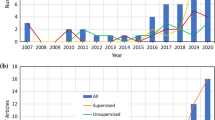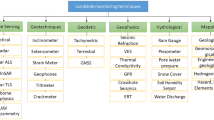Abstract
The development of seismic microzonation maps is now a prerequisite for performing advanced seismic hazards and seismic risk assessments in urban areas. Current microzonation procedures are based on classifying site response in soil categories based on \(\hbox {V}_\mathrm{S30}\). In many practical cases, information on shear wave velocity is sparse and analysts must resort to other sources of information to develop zonation maps over large regions. For Montreal, Canada, a geostatistical approach combining a large dataset of boreholes, \(\hbox {f}_{0}\) data from the H/V method, and a limited number of shear wave velocity measurements is proposed. Predictive equations are developed with the different types of information and partly used to create three different \(\hbox {V}_\mathrm{s30}\) models: A first model based on the total thickness of soft soil deposits (One Layer Model), a second model based on stratigraphy obtained from borehole data (Four Layers Model) and a third model (Composite Model) that combines data from the previous two models with data from seismic surveys. Variability and uncertainty associated with the choice of the models are described and estimated using a second moment analysis. The composite model which combines borehole, \(\hbox {f}_{0}\) and Vs data is shown to be the most accurate compared to models derived only from borehole and Vs data (an average reduction of 40 % of the squared error) and shows good agreement with the geological map for clay and sand locations with soils classes C and D (54 % agreement on average). This approach opens new perspectives for \(\hbox {V}_\mathrm{s30}\) microzonation in urban areas when budgets for Vs surveys are limited.









Similar content being viewed by others
References
Adams J (2011) Seismic hazard maps for the national building code of Canada. In: Proceeding of the CSCE 2011 general conference, Ottawa
Adams J, Halchuk S (2003) Fourth generation seismic hazard maps of Canada: values for over 650 Canadian localities intended for the 2005 National Building Code of Canada. Geological Survey of Canada Open File 4459. 155 p. http://www.seismo.nrcan.gc.ca as of 1 April 2003
Ansal A, Asli K, Gokce T (2010) Seismic microzonation and earthquake damage scenarios for urban areas. Soil Dyn Earthq Eng 30:1319–1328
Baker JW (2011) Conditional mean spectrum: tool for ground motion selection. J Struct Eng 137(3):322–331
Benjamin JR, Cornell CA (1970) Probability, statistics and decisions for civil engineers. McGraw-Hill, New York
Castellaro S, Mulargia F (2009) VS30 estimates using constrained H/V measurements. Bull Seismol Soc Am 99:761–773
Castellaro S, Mulargia F, Rossi PL (2008) \(\text{ V }_{\rm S30}\): proxy for seismic amplification? Seismol Res Lett 79:540–543
Chouinard LE, Rosset P (2007) Seismic site effects and seismic risk in the Montreal urban area. The influence of marine clays. In: Proceedings of the ninth Canadian conference on earthquake engineering, Ottawa, Ontario, Canada, pp 26–29
Chouinard LE, Rosset P (2011) Microzonation of Montreal, variability in soil classification. In: Proceeding of the 4th IASPEI /IAEE international symposium, Santa Barbara
Chouinard LE, Rosset P (2012) On the use of ambient noise technique for microzonation purposes: the case of Montreal. In: Hunter JA and Crow, HL (eds) Shear wave velocity measurement guidelines for Canadian seismic site characterization in soil and rock. Geological Survey of Canada, Open File 7078, pp 85–92
Di Capua G, Compagnoni M, Di Giulio G et al (2014) The seismic microzonation of level 3 of Sant’Agata Fossili (northern Italy) based on a multidisciplinary approach. Ann Geophys 57(1):S0189
Haldar A, Mahadevan S (2000) Probability, reliability, and statistical methods in engineering design. Wiley, New York
Hunter JA, Burns RA, Good RL, Pullan SE, Harris JB, Skvortzov A, Goriainov NN (1998) Downhole seismic logging for high-resolution reflection surveying in unconsolidated overburden. Geophysics 63(4):1371–1384
Hunter JA, Crow HL (2012) Shear wave velocity measurement guidelines for Canadian seismic site characterization in soil and rock. Geological Survey of Canada, Open File 7078: doi:10.4095/291753
Hunter JA, Crow HL, Brooks GR et al. (2010) Seismic site classification and site period mapping in the ottawa area using geophysical methods. Geological Survey of Canada, Open File 6273, 1 DVD
Idriss IM, Sun JI (1992) User’s Manual for SHAKE91. Department of Civil Engineering, University of California, Davis,Center for Geotechnical Modeling
Kunstmann H, Kinzelbach W, Siegfried T (2002) Conditional first-order second-moment method and its application to the quantification of uncertainty in groundwater modeling. Water Resour Res 38(4):1035
Lamontagne M, Halchuk S, Cassidy JF, Rogers GC (2008) Significant Canadian earthquakes of the period 1600–2006. Seismol Res Lett 79(2):211–223
Leblanc G (1981) A closer look at the September 1732, Montreal earthquake. Can J Earth Sci 18(3):539–550
Lebrun B, Duval A-M, Bard P-Y, Monge O, Bour M, Vidal S, Fabriol H (2004) Seismic microzonation: a comparison between geotechnical and seismological approaches in Pointe-à–Pitre (French West Indies). Bull Earthq Eng 2:27–50
Luzi L, Puglia R, Pacor F, Gallipoli M, Bindi D, Mucciarelli M (2011) Proposal for a soil classification based on parameters alternative or complementary to \(\text{ V }_{\rm S30}\). Bull Earthq Eng 9(6):1877–1898
Mavko G, Mukerji T, Dvorkin J (1998) The rock physics handbook: tools for seismic analysis in porous media. Cambridge University Press, Cambridge
Mitchell D, Tinawi R, Law T (1990) Damage caused by the November 25, 1988 Saguenay earthquake. Can J Civ Eng 17(3):338–365
Motazedian D, Hunter JA, Belvaux M et al (2010) Seismic microzonation of Montreal and Ottawa, Canada. In: Proceedings of the 10th Canadian & 9th US National Conference on Earthquake Engineering, Toronto, ON, July 2010
Motazedian D, Hunter JA, Pugin A, Crow HL (2011) Development of a VS30 (NEHRP) map for the city of Ottawa, Ontario, Canada. Can Geotech J 48:458–472
NBCC (2010) Canadian commission on building and fire codes. National Research Council Canada, Ottawa, Ontario, National Building Code of Canada (NBCC)
Park CB (2010) MASW analysis, dispersion images and curve extracted for Montreal data. Internal report to Prof. Chouinard., 26 slides
Park CB, Miller RD, Ryden N, Xia J, Ivanov J (2005) Combined use of active and passive surface waves. J Environ Eng Geophys 10(3):323–334
Prest VK, Hode-Keyser J (1977) Geology and engineering characteristics of surficial deposits, Montreal island and vicinity, Quebec. Geological Survey Paper, pp 75–27
Pugin A, Hunter JA, Motazedian D, Khaheshi-Banab K (2007) An application of shear wave reflection landstreamer technology to soil response evaluation of earthquake shaking in an urban area, Ottawa, Ontario. In: SAGEEP Conference Bulletin
Pugin A, Pullan SE, Hunter JA (2008) SV-wave and P-wave high resolution seismic reflection using vertical impacting and vibrating sources. In: Proceedings of SAGEEP’08 Philadelphia, PA, April 6–10
Rosset P, Chouinard LE (2009) Characterization of site effects in Montreal, Canada. Nat Hazards 48:295–308
Scott JB, Rasmussen T, Luke B, Taylor WJ et al (2006) Shallow shear velocity and seismic microzonation of the urban Las Vegas, Nevada, Basin. Bull Seismol Soc Am 96(3):1068–1077
Sibson R (1981) A brief description of natural neighbor interpolation (Chapter 2). In: Barnett V (ed) Interpreting multivariate data. Wiley, Chichester, pp 21–36
Thompson EM, Baise LG, Kayen RE, Tanaka Y, Tanaka H (2010) A geostatistical approach to mapping site response spectral amplifications. Eng Geol 114:330–342
Wise D (2000) Geology of the West Island: pride of place, Caring for Community 4.17. unpublished document
Zhao JX, Irikura K, Zhang J, Fukushima Y et al (2006) An empirical site-classification method for strong-motion stations in Japan using H/V response spectral ratio. Bull Seismol Soc Am 96:914–925
Acknowledgments
The authors thank the anonymous reviewers for their comments to improve the paper. Jim Hunter and his team at the Geological Survey of Canada in Ottawa are warmly thanked for their technical and scientific support in the collection of seismic data in Montreal. Darius Motazedian (Carleton University) provided us with instruments for seismic refraction during a campaign. The borehole data base is maintained by the City of Montreal. This work is supported by the Natural Sciences and Engineering Research Council of Canada (NSERC).
Author information
Authors and Affiliations
Corresponding author
Rights and permissions
About this article
Cite this article
Rosset, P., Bour-Belvaux, M. & Chouinard, L. Microzonation models for Montreal with respect to \(\hbox {V}_\mathrm{S30}\) . Bull Earthquake Eng 13, 2225–2239 (2015). https://doi.org/10.1007/s10518-014-9716-8
Received:
Accepted:
Published:
Issue Date:
DOI: https://doi.org/10.1007/s10518-014-9716-8




